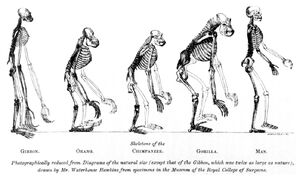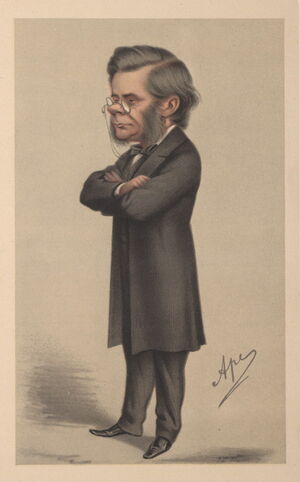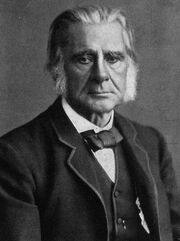No edit summary |
(clean up, typos fixed: emigrée → émigrée, well-known → well known) |
||
| Line 34: | Line 34: | ||
Huxley resigned from the navy and, in July 1854, he became lecturer at the School of Mines]] and naturalist to the Geological Survey in the following year. His most important research belonging to this period was the Croonian Lecture, delivered before the Royal Society, in 1858, on ''The Theory of the Vertebrate Skull''. In this, he rejected [[Richard Owen]]'s view that the bones of the skull and the spine were [[homology (biology)|homologous]], an opinion previously held by [[Johann Wolfgang von Goethe|Goethe]] and [[Lorenz Oken]]. |
Huxley resigned from the navy and, in July 1854, he became lecturer at the School of Mines]] and naturalist to the Geological Survey in the following year. His most important research belonging to this period was the Croonian Lecture, delivered before the Royal Society, in 1858, on ''The Theory of the Vertebrate Skull''. In this, he rejected [[Richard Owen]]'s view that the bones of the skull and the spine were [[homology (biology)|homologous]], an opinion previously held by [[Johann Wolfgang von Goethe|Goethe]] and [[Lorenz Oken]]. |
||
| − | Huxley is also well |
+ | Huxley is also well known for his treatise on physiography which is a detailed physical geography of the Thames River Basin, published in 1878. |
=== Marriage and family === |
=== Marriage and family === |
||
| − | In [[1855]], he married Henrietta Anne Heathorn ([[1825]]-[[1915]]), an English |
+ | In [[1855]], he married Henrietta Anne Heathorn ([[1825]]-[[1915]]), an English émigrée whom he had met in Sydney. They kept correspondence until he was able to send for her. They had five daughters and three sons, including the writer Leonard Huxley ([[1860]]-[[1933]]): |
* Noel Huxley ([[1856]]-[[1860]]) died aged 4. |
* Noel Huxley ([[1856]]-[[1860]]) died aged 4. |
||
| Line 43: | Line 43: | ||
* Marian Huxley ([[1859]]-[[1889]]) married artist [[John Collier]] in [[1879]]. |
* Marian Huxley ([[1859]]-[[1889]]) married artist [[John Collier]] in [[1879]]. |
||
* Leonard Huxley ([[1860]]-[[1933]]) famous author. |
* Leonard Huxley ([[1860]]-[[1933]]) famous author. |
||
| − | * Rachel Huxley ([[1862]]-[[1934]]) married civil engineer Alfred Eckersley in 1884, he died 1895. |
+ | * Rachel Huxley ([[1862]]-[[1934]]) married civil engineer Alfred Eckersley in 1884, he died 1895. |
* Nettie Huxley ([[1863]]-[[1940]]), married Harold Roller, travelled Europe as a singer. |
* Nettie Huxley ([[1863]]-[[1940]]), married Harold Roller, travelled Europe as a singer. |
||
* Henry Huxley ([[1865]]-[[1946]]), became a fashionable [[general practitioner]] in [[London]]. |
* Henry Huxley ([[1865]]-[[1946]]), became a fashionable [[general practitioner]] in [[London]]. |
||
| Line 148: | Line 148: | ||
[[zh:托马斯·亨利·赫胥黎]] |
[[zh:托马斯·亨利·赫胥黎]] |
||
{{enWP|Thomas Huxley}} |
{{enWP|Thomas Huxley}} |
||
| + | {{Persondata |
||
| + | | NAME = |
||
| + | | ALTERNATIVE NAMES = |
||
| + | | SHORT DESCRIPTION = |
||
| + | | DATE OF BIRTH = 1825 |
||
| + | | PLACE OF BIRTH = |
||
| + | | DATE OF DEATH = 1895 |
||
| + | | PLACE OF DEATH = |
||
| + | }} |
||
Latest revision as of 23:23, 23 September 2012
Assessment |
Biopsychology |
Comparative |
Cognitive |
Developmental |
Language |
Individual differences |
Personality |
Philosophy |
Social |
Methods |
Statistics |
Clinical |
Educational |
Industrial |
Professional items |
World psychology |
Biological: Behavioural genetics · Evolutionary psychology · Neuroanatomy · Neurochemistry · Neuroendocrinology · Neuroscience · Psychoneuroimmunology · Physiological Psychology · Psychopharmacology (Index, Outline)
Thomas Henry Huxley, FRS (4 May 1825 – 29 June 1895) [1] was an English biologist, known as "Darwin's Bulldog" for his advocacy of Charles Darwin's theory of evolution.[1]
Thomas Huxley's most famous debate was against Archbishop Samuel Wilberforce who was coached by Richard Owen (who he also debated against). He demonstrated that there were close similarities between the cerebral anatomy of humans and gorillas. Huxley did not accept many of Darwin's ideas, such as gradualism and was more interested in advocating a materialist professional science than in defending natural selection.
A talented populariser of science, he coined the term "agnosticism" [1] to describe his stance on religious belief (see Thomas Henry Huxley and agnosticism).
In evolution, Huxley developed the concept of the "Pithecometra principle" (analogous to "man evolved from apes") that was discussed by Charles Darwin and Ernst Haeckel, from Huxley's 1863 essay "On the Origin of Species" stating that man was more closely related to apes than apes were to monkeys (details below). [2]
Huxley is also credited with inventing the concept of "biogenesis", a theory stating that all cells arise from other cells and also "abiogenesis", describing the generation of life from non-living matter.
Biography
Early life
Huxley, born in Ealing in west London, was the second youngest of eight children of George Huxley, a teacher of mathematics in Ealing. At seventeen he commenced regular medical studies at Charing Cross Hospital, where he had obtained a scholarship. At twenty he passed his first M.B. examination, at the University of London, winning the gold medal for anatomy and physiology. In 1845, he published his first scientific paper, demonstrating the existence of a hitherto unrecognized layer in the inner sheath of hairs, a layer that has been known since as Huxley's layer.
Voyage of the Rattlesnake
Huxley then applied for an appointment in the navy. He obtained the post of assistant surgeon to HMS Rattlesnake, about to start for surveying work in Torres Strait. Rattlesnake left England on December 3, 1846 and, once they had arrived in the southern hemisphere, Huxley devoted his time to the study of marine invertebrates. He began to send details of his discoveries back to England and his paper, On the Anatomy and the Affinities of the Family of Medusae, was printed by the Royal Society in the 'Philosophical Transactions', in 1849. Huxley united the Hydroid and Sertularian polyps with the Medusae, to form a class to which he subsequently gave the name of Hydrozoa. The connection he made was that all the members of the class consisted of two membranes, enclosing a central cavity or stomach. This is characteristic of what are now called the Cnidaria. He compared this feature to the serous and mucous structures of embryos of higher animals.
The value of Huxley's work was recognized and, on returning to England, in 1850, he was elected a Fellow of the Royal Society. In the following year, at the age of twenty-six, he not only received the Royal medal but was also elected on the council. He secured the friendship of Joseph Dalton Hooker and John Tyndall, who remained his lifelong friends. The Admiralty retained him as a nominal assistant-surgeon, in order that he might work on the observations he had made during the voyage of Rattlesnake. He was thus enabled to produce various important memoirs, especially those on certain Ascidians, in which he solved the problem of Appendicularian organism, whose place in the animal kingdom Johannes Peter Müller had found himself wholly unable to assign and on the morphology of the Cephalous Mollusca.
Later life
Huxley resigned from the navy and, in July 1854, he became lecturer at the School of Mines]] and naturalist to the Geological Survey in the following year. His most important research belonging to this period was the Croonian Lecture, delivered before the Royal Society, in 1858, on The Theory of the Vertebrate Skull. In this, he rejected Richard Owen's view that the bones of the skull and the spine were homologous, an opinion previously held by Goethe and Lorenz Oken.
Huxley is also well known for his treatise on physiography which is a detailed physical geography of the Thames River Basin, published in 1878.
Marriage and family
In 1855, he married Henrietta Anne Heathorn (1825-1915), an English émigrée whom he had met in Sydney. They kept correspondence until he was able to send for her. They had five daughters and three sons, including the writer Leonard Huxley (1860-1933):
- Noel Huxley (1856-1860) died aged 4.
- Jessie Oriana Huxley (1856-1927), married architect Fred Waller in 1877.
- Marian Huxley (1859-1889) married artist John Collier in 1879.
- Leonard Huxley (1860-1933) famous author.
- Rachel Huxley (1862-1934) married civil engineer Alfred Eckersley in 1884, he died 1895.
- Nettie Huxley (1863-1940), married Harold Roller, travelled Europe as a singer.
- Henry Huxley (1865-1946), became a fashionable general practitioner in London.
- Ethel Huxley (1866-1941) married artist John Collier (widower of sister) in 1889.
- His grandson, Aldous Huxley, was author of Brave New World
Darwin's bulldog

In the frontispiece from his 1863 Evidence as to Man's Place in Nature, Huxley first printed a famous image of his comparing the skeletons of apes to humans.

A famous cartoon image appearing in Vanity Fair representing Huxley during the Wilberforce-Huxley debate.
In 1859, Charles Darwin's The Origin of Species was published. Huxley had previously rejected Jean-Baptiste Lamarck's theory of transmutation, on the basis that there was insufficient evidence to support it. However, he believed that Darwin at least gave a hypothesis which was good enough as a working basis, even though he believed evidence was still lacking and became one of Darwin's main supporters in the debate that followed the book's publication. He did this in a lecture at the Royal Institution, in February 1860 and spoke in favour of Darwin's theory of natural selection in the debate at the British Association meeting, at the Oxford University Museum, in June. He was joined on this occasion by his friend Hooker and they were opposed by the Bishop of Oxford, Samuel Wilberforce and Robert FitzRoy, the captain of HMS Beagle.
Following this, Huxley concentrated on the subject of man's origins, maintaining that man was related to apes. In this he was opposed by Richard Owen, who stated that man was clearly marked off from all other animals by the anatomical structure of his brain. This was actually inconsistent with known facts and was effectually refuted by Huxley in various papers and lectures, summed up in 1863 in Evidence as to Man's Place in Nature.
The thirty-one years during which Huxley occupied the chair of natural history at the School of Mines were largely occupied with palaeontological research. Numerous memoirs on fossil fishes established many far-reaching morphological facts. The study of fossil reptiles led to his demonstrating, in the course of lectures on birds, delivered at the Royal College of Surgeons, in 1867, the fundamental affinity of the two groups which he united under the title of Sauropsida.
From 1870 onwards, he was drawn away from scientific research by the claims of public duty. From 1862 to 1884 he served on ten Royal Commissions. From 1871 to 1880 he was a secretary of the Royal Society and from 1881 to 1885 he was president. He was made a Privy Councillor in 1892. In 1870, he was president of the British Association at Liverpool and, in the same year was elected a member of the newly-constituted London School Board. In 1888, he was awarded the Copley Medal by the Royal Society.
His health completely broke down in 1885. In 1890, he moved from London to Eastbourne, where, after a painful illness, he died.
Huxley was the founder of a very distinguished family of British academics, including his grandsons Aldous Huxley (the writer), Sir Julian Huxley (the first Director General of UNESCO and a founder of the World Wide Fund for Nature) and Sir Andrew Huxley (the physiologist and Nobel laureate).
Huxley is credited with the quote, "Try to learn something about everything and everything about something".

Thomas Henry Huxley
Educational influence
Huxley was a major influence in the direction taken by British schools. In primary schooling, he advocated a wide range of disciplines, similar to what is taught today: reading, writing, arithmetic, art, science, music, etc. In higher education he also foresaw how schools should be run, with two years of basic liberal studies followed by two years of some upper-division work, focusing on a more specific area of study. This was a fresh approach to the general study of classics in contemporary English colleges. Much of his educational approach is found in his work On a Piece of Chalk [1], a profound essay first published in MacMillan's Magazine in London, 1868. The piece reconstructs the geological history of Britain, from a simple piece of chalk and demonstrates the methods of science as "organized common sense".
Huxley also advocated teaching the Bible in schools. This may seem out of step with his evolutionary theories and personal agnostic convictions but he believed that the Bible's significant literary and moral teachings were quite relevant to English ethics.
He tried to reconcile evolution and ethics, in his book Evolution and Ethics, which proposed the principle of the "fitting of as many as possible to survive". An essay published in that collection, The Struggle for Existence in Human Society (first published in Nineteenth Century), prompted Peter Kropotkin to write the classic Mutual Aid: A Factor of Evolution, in critique of Huxley's brand of Social Darwinism.
His large sideburns were also seen as an influence on others, especially Canadian Prime Minister, Sir Charles Tupper.
Racial classification system
In On the Methods and Results of Ethnology (1865), Huxley defined the Ulotrichi race to be one of two macroraces. This macrorace contained the Bushmen, Negrito, Negroes and Mincopies. The other, the Leiotrichi, contained the Amphinesians, Americans, Melanochroi, Xanthochroi, Australians, Esquimaux and Mongolians.
Huxley defined the Mincopies to be the indigenous peoples of the Andaman and Nicobar Islands.
The Xanthochroi were defined to be the indigenous peoples from the Rhine east to the Yenisei and from the Urals south to the Hindu Kush. Included were the Scandinavians, Germans, Slavonians and Finns. Also included were some of the Greeks, Turks, Kirghiz, Mantchous, Ossetes, Siahposh and Rohillas. He described them as having fair skin, yellow or red hair, blue eyes and long or broad heads. Huxley's concept was influential in the development of the theory of the Nordic race.
The Melanochroi were defined as the indigenous peoples of Southern Europe, the Middle East, Southwest Asia and North Africa. Huxley described this region as having a Y shape. He included in this category some of the British, Gauls, Spanish, Italians, Greeks, Syrians, Arabs and Persians, as well as the Celts, Iberians, Etruscans, Romans, Pelasgians, Berbers, Saharans, North Africans and Semites. He described them as having pale skin and wavy hair, with abundant beards, black hair, long heads and dark eyes. He concluded the dark-skinned Melanochroi might be the product of the dark-skinned Australian race mixing with the light-skinned Xanthochroi race.[3]
Template:Thomas Huxley Racial Definitions
Notes
- ↑ 1.0 1.1 1.2 "Huxley, T.H." (history), Encyclopædia Britannica Online, 2006, Britannica.com webpage: EB-THHuxley.
- ↑ "Cultural Biases Reflected in the Hominid Fossil Record" (history), by By Joshua Barbach and Craig Byron, 2005, ArchaeologyInfo.com webpage: ArchaeologyInfo-003.
- ↑ Huxley, Thomas. On the Geographical Distribution of the Chief Modifications of Mankind. 1870. August 14, 2006. <http://aleph0.clarku.edu/huxley/SM3/GeoDis.html>.
References
- P. Chalmers Mitchell, Thomas Henry Huxley; A Sketch of his Life and Work, 1900, from Project Gutenberg.
External links
- The Huxley File at Clark University - Contains most of his writing.
- Works by Thomas Henry Huxley at Project Gutenberg
- Physiography by T.H. Huxley, 1878 Huxley's famous book on the physical geography of the Thames River Basin. Free to read and search courtesy the Carnegie Museum of Natural History Library.
- Thomas Henry Huxley; A Sketch of his Life and Work, by P. Chalmers Mitchell, 1900, from Project Gutenberg
- An examination of the evidence for what was really said by Wilberforce and Huxley in the 1860 debate on Darwinism.
- A Liberal Education
- The Thomas Henry Huxley Award, awarded annually for original work in zoology
- "Has a Frog A Soul", by Thomas Henry Huxley - audio download from LibriVox
| Honorary titles
| ||
|---|---|---|
| Preceded by: William Spottiswoode |
President of the Royal Society 1883–1885 |
Succeeded by: Sir George Stokes |
cs:Thomas Henry Huxley de:Thomas Henry Huxley el:Τόμας Χάξλεϋ es:Thomas Henry Huxley fr:Thomas Henry Huxley ko:토머스 헉슬리 he:תומס הנרי הקסלי ka:ჰაქსლი, ტომას ჰენრი nl:Thomas Huxley no:Thomas Huxley pt:Thomas Henry Huxley ru:Хаксли, Томас Генри sk:Thomas Henry Huxley fi:Thomas Henry Huxley sv:Thomas Henry Huxley zh:托马斯·亨利·赫胥黎
| This page uses Creative Commons Licensed content from Wikipedia (view authors). |
| ||||||||||||||||

